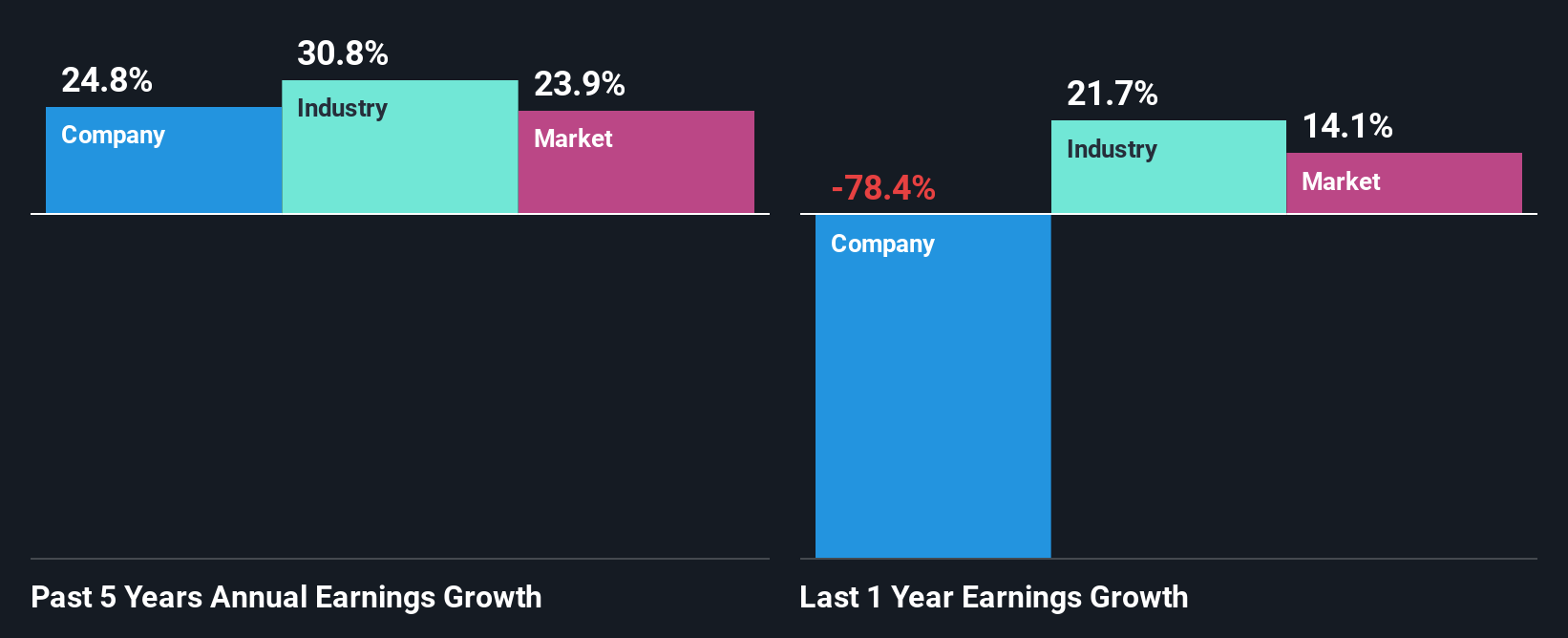- India
- /
- Commercial Services
- /
- NSEI:NAMAN
Declining Stock and Decent Financials: Is The Market Wrong About Naman In-Store (India) Limited (NSE:NAMAN)?
With its stock down 20% over the past three months, it is easy to disregard Naman In-Store (India) (NSE:NAMAN). But if you pay close attention, you might find that its key financial indicators look quite decent, which could mean that the stock could potentially rise in the long-term given how markets usually reward more resilient long-term fundamentals. Particularly, we will be paying attention to Naman In-Store (India)'s ROE today.
Return on equity or ROE is an important factor to be considered by a shareholder because it tells them how effectively their capital is being reinvested. In other words, it is a profitability ratio which measures the rate of return on the capital provided by the company's shareholders.
How Do You Calculate Return On Equity?
The formula for ROE is:
Return on Equity = Net Profit (from continuing operations) ÷ Shareholders' Equity
So, based on the above formula, the ROE for Naman In-Store (India) is:
2.3% = ₹18m ÷ ₹797m (Based on the trailing twelve months to September 2025).
The 'return' is the amount earned after tax over the last twelve months. Another way to think of that is that for every ₹1 worth of equity, the company was able to earn ₹0.02 in profit.
See our latest analysis for Naman In-Store (India)
What Has ROE Got To Do With Earnings Growth?
So far, we've learned that ROE is a measure of a company's profitability. Based on how much of its profits the company chooses to reinvest or "retain", we are then able to evaluate a company's future ability to generate profits. Assuming everything else remains unchanged, the higher the ROE and profit retention, the higher the growth rate of a company compared to companies that don't necessarily bear these characteristics.
A Side By Side comparison of Naman In-Store (India)'s Earnings Growth And 2.3% ROE
As you can see, Naman In-Store (India)'s ROE looks pretty weak. Not just that, even compared to the industry average of 13%, the company's ROE is entirely unremarkable. In spite of this, Naman In-Store (India) was able to grow its net income considerably, at a rate of 25% in the last five years. We reckon that there could be other factors at play here. Such as - high earnings retention or an efficient management in place.
As a next step, we compared Naman In-Store (India)'s net income growth with the industry and found that the company has a similar growth figure when compared with the industry average growth rate of 31% in the same period.

Earnings growth is an important metric to consider when valuing a stock. It’s important for an investor to know whether the market has priced in the company's expected earnings growth (or decline). By doing so, they will have an idea if the stock is headed into clear blue waters or if swampy waters await. One good indicator of expected earnings growth is the P/E ratio which determines the price the market is willing to pay for a stock based on its earnings prospects. So, you may want to check if Naman In-Store (India) is trading on a high P/E or a low P/E, relative to its industry.
Is Naman In-Store (India) Using Its Retained Earnings Effectively?
Given that Naman In-Store (India) doesn't pay any regular dividends to its shareholders, we infer that the company has been reinvesting all of its profits to grow its business.
Summary
On the whole, we do feel that Naman In-Store (India) has some positive attributes. With a high rate of reinvestment, albeit at a low ROE, the company has managed to see a considerable growth in its earnings. While we won't completely dismiss the company, what we would do, is try to ascertain how risky the business is to make a more informed decision around the company. You can see the 4 risks we have identified for Naman In-Store (India) by visiting our risks dashboard for free on our platform here.
Valuation is complex, but we're here to simplify it.
Discover if Naman In-Store (India) might be undervalued or overvalued with our detailed analysis, featuring fair value estimates, potential risks, dividends, insider trades, and its financial condition.
Access Free AnalysisHave feedback on this article? Concerned about the content? Get in touch with us directly. Alternatively, email editorial-team (at) simplywallst.com.
This article by Simply Wall St is general in nature. We provide commentary based on historical data and analyst forecasts only using an unbiased methodology and our articles are not intended to be financial advice. It does not constitute a recommendation to buy or sell any stock, and does not take account of your objectives, or your financial situation. We aim to bring you long-term focused analysis driven by fundamental data. Note that our analysis may not factor in the latest price-sensitive company announcements or qualitative material. Simply Wall St has no position in any stocks mentioned.
About NSEI:NAMAN
Naman In-Store (India)
Manufactures and sells customized retail store fixtures and furniture in India.
Adequate balance sheet with slight risk.
Market Insights
Community Narratives



